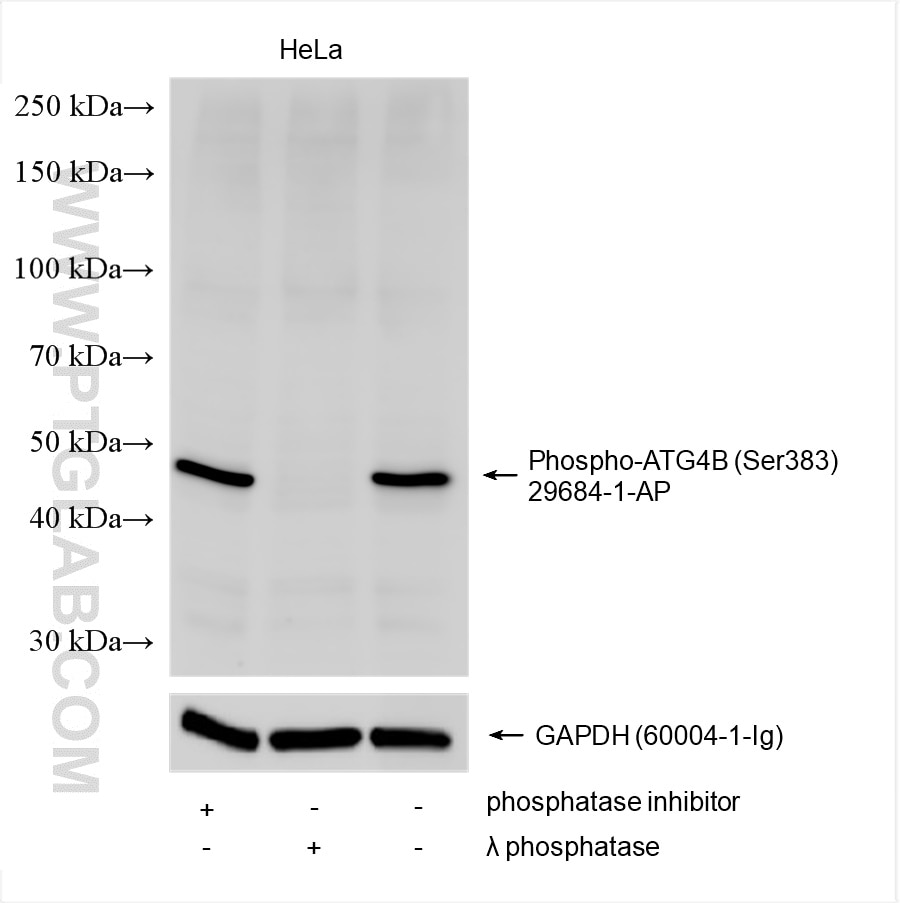Phospho-ATG4B (Ser383) Polyklonaler Antikörper
Phospho-ATG4B (Ser383) Polyklonal Antikörper für WB, ELISA
Wirt / Isotyp
Kaninchen / IgG
Getestete Reaktivität
human
Anwendung
WB, ELISA
Konjugation
Unkonjugiert
Kat-Nr. : 29684-1-AP
Synonyme
Geprüfte Anwendungen
| Erfolgreiche Detektion in WB | Mit λ-Phosphatase behandelte HeLa-Zellen |
Empfohlene Verdünnung
| Anwendung | Verdünnung |
|---|---|
| Western Blot (WB) | WB : 1:500-1:2000 |
| It is recommended that this reagent should be titrated in each testing system to obtain optimal results. | |
| Sample-dependent, check data in validation data gallery | |
Veröffentlichte Anwendungen
| WB | See 1 publications below |
Produktinformation
29684-1-AP bindet in WB, ELISA Phospho-ATG4B (Ser383) und zeigt Reaktivität mit human
| Getestete Reaktivität | human |
| In Publikationen genannte Reaktivität | human |
| Wirt / Isotyp | Kaninchen / IgG |
| Klonalität | Polyklonal |
| Typ | Antikörper |
| Immunogen | Peptid |
| Vollständiger Name | ATG4 autophagy related 4 homolog B (S. cerevisiae) |
| Berechnetes Molekulargewicht | 44 kDa |
| Beobachtetes Molekulargewicht | 44 kDa |
| GenBank-Zugangsnummer | BC000719 |
| Gene symbol | ATG4B |
| Gene ID (NCBI) | 23192 |
| Konjugation | Unkonjugiert |
| Form | Liquid |
| Reinigungsmethode | Antigen-Affinitätsreinigung |
| Lagerungspuffer | PBS with 0.02% sodium azide and 50% glycerol |
| Lagerungsbedingungen | Bei -20°C lagern. Nach dem Versand ein Jahr lang stabil Aliquotieren ist bei -20oC Lagerung nicht notwendig. 20ul Größen enthalten 0,1% BSA. |
Hintergrundinformationen
ATG4B stimulates autophagy by promoting autophagosome formation through reversible modification of ATG8. In humans, microtubule-associated protein 1 light chain, LC3B, is the best-characterized ATG8 isoform, and ATG4B, but not three other ATG4 isoforms, displays a highly selective preference toward LC3B. MST4 phosphorylates ATG4B at serine residue 383, which stimulates ATG4B activity and increases autophagic flux. (PMID: 29232556, PMID: 36056541)
Protokolle
| PRODUKTSPEZIFISCHE PROTOKOLLE | |
|---|---|
| WB protocol for Phospho-ATG4B (Ser383) antibody 29684-1-AP | Protokoll herunterladen |
| STANDARD-PROTOKOLLE | |
|---|---|
| Klicken Sie hier, um unsere Standardprotokolle anzuzeigen |


